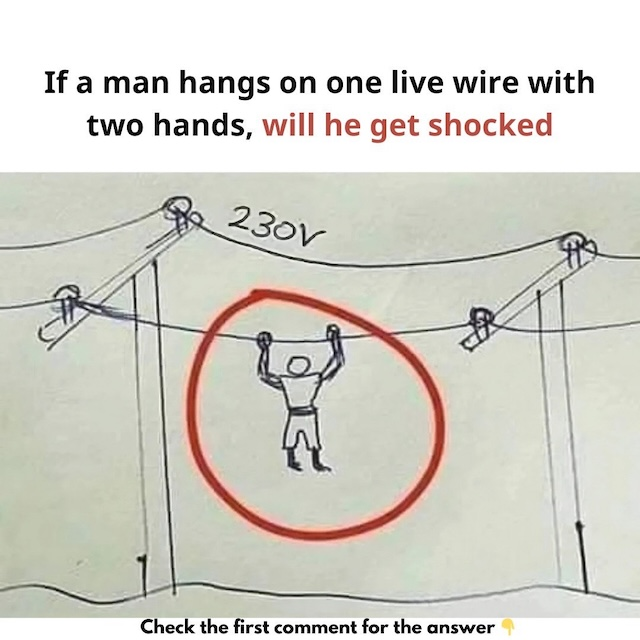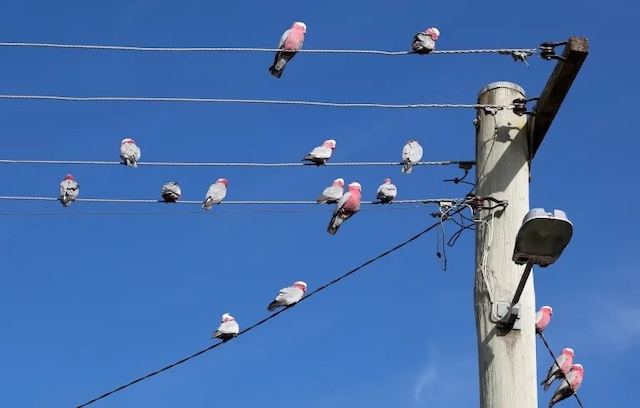You’ve seen it before—birds casually perched on high-voltage power lines like it’s just another day in the sky. No sparks. No drama. Just feathers and voltage peacefully coexisting. But here’s the mind-bending question: if birds can sit on power lines without getting electrocuted, can humans do the same? What if a person grabs onto a live wire with both hands—would they get shocked?
This question might sound like a hypothetical riddle, but the science behind it is real, fascinating, and crucial for understanding how electricity behaves. Let’s walk through this electrifying puzzle step-by-step and bust a few myths along the way.

Common Misconceptions About Electricity and Live Wires
Before we dive into the science, let’s clear the air. Electricity can be terrifying, and that fear often leads to false assumptions. Here are a few popular misunderstandings:
“Touching a live wire will always kill you.”
Not necessarily. The danger depends on whether your body becomes part of a completed circuit.
“Birds are immune to electricity.”
Nope. Birds aren’t immune—they’re just smart enough (or lucky enough) not to bridge the circuit.
“It’s only safe if the voltage is low.”
Actually, it’s not just about voltage—it’s about whether the current has a path to travel through your body to a different voltage level or the ground.
Electricity follows simple laws of physics. The tricky part is how often we ignore or misread those laws in real life.
Why Birds Don’t Get Shocked on Power Lines
Video: Why don’t birds get electrocuted on power lines?
Let’s start with our feathered friends. Birds can safely perch on live wires because they’re only touching one wire at a time. Electricity needs a pathway—it flows from a point of high potential to low potential. If a bird touches just one wire, there’s no difference in voltage across its body. No voltage difference means no current flows—and no shock.
Now, if that same bird were to stretch out and touch another wire with a different voltage, or a grounded pole? Game over. It would become the perfect bridge for electricity to travel—and that’s when a shock happens.
So, Can a Human Hang From a Live Wire Without Getting Shocked?

This is where things get interesting. The answer is: yes, but only under extremely specific conditions.
If a person grabs onto a single high-voltage wire—say, by both hands—and doesn’t touch anything else, including the ground or another wire, then technically, they won’t get shocked. Just like the bird, their body would be at the same electrical potential as the wire, and no current would pass through them.
In essence, they become part of the wire. Sounds crazy, right?
But—and this is a huge “but”—any secondary contact would be fatal. If that same person reached out with one hand and touched another object at a different voltage (like a metal pole, tree branch, or even a damp structure), electricity would flow through their body to the lower voltage point. And that flow of electricity? That’s what causes the shock—or worse.
Breaking Down the Science of Electric Circuits
To really understand this, we need to talk about electric circuits.
Electricity is all about movement—specifically, the movement of electrons. But for current to flow, it needs a complete circuit. Think of it like a racetrack. You need a starting line (power source), a finish line (ground or return path), and a clear path between them. Without that full loop, the electrons have nowhere to go.
If you’re hanging in midair touching only one wire, you’re not completing the loop. No loop means no current. No current means no shock.
What Happens If You Touch Another Wire or the Ground?
Video: Why Don’t Birds on Power Lines Get Zapped?
Let’s say our hypothetical daredevil reaches out and grabs a second wire—this one at a different voltage—or somehow touches the ground. Now we’ve got a path. The electricity sees your body as the perfect conductor and takes a ride through it. The result is a potentially lethal shock.
Even just brushing against a tree branch, metal pipe, or anything that’s grounded could change the outcome instantly. That’s why linemen use insulating equipment and follow strict protocols when working on live wires. They’re not defying the laws of physics—they’re carefully navigating them.
Real-World Factors Make This Incredibly Dangerous
Even if it’s “theoretically” safe to hang from one wire, real life doesn’t play nice with theory. Here are a few factors that make this situation incredibly risky:
- Wind could push the person into another wire or grounded structure
- Rain or moisture could reduce air resistance and conduct electricity more easily
- Panic or movement could cause a loss of balance or accidental contact
- Voltage surges or fluctuations could spike unexpectedly
This is why no professional would ever recommend testing this theory in real life. Electricity might be predictable in physics class, but in nature, it plays by its own rules.
What We Can Learn From This Puzzle

It’s easy to treat this like a fun brain teaser, but there’s real educational value here too. Understanding how electricity flows helps demystify it—and reduces fear by replacing it with knowledge. More importantly, it teaches us that you don’t have to see electricity for it to be deadly.
The key takeaways?
- Electricity needs a complete circuit to flow
- No current = no shock
- Birds are safe because they don’t complete the circuit
- Humans could be safe—but only under very precise, risky conditions
- Any accidental second contact could be fatal
Conclusion: Respect the Wire—Knowledge Is Power, But Safety Is Everything
So here’s the bottom line: Yes, it’s possible to hang from a live wire without getting shocked—as long as you touch absolutely nothing else. But that doesn’t make it safe. The tiniest misstep or misjudgment could turn theory into tragedy.
Birds aren’t superheroes—they’re just unknowingly obeying the laws of physics. And you? You’re smarter. Now that you understand how electrical circuits work, you can appreciate the balance of power (literally) and stay safe while staying curious.
Have a theory of your own? Share it in the comments and challenge your friends with this electrifying question. Just remember—knowledge can be shocking, but safety always comes first


